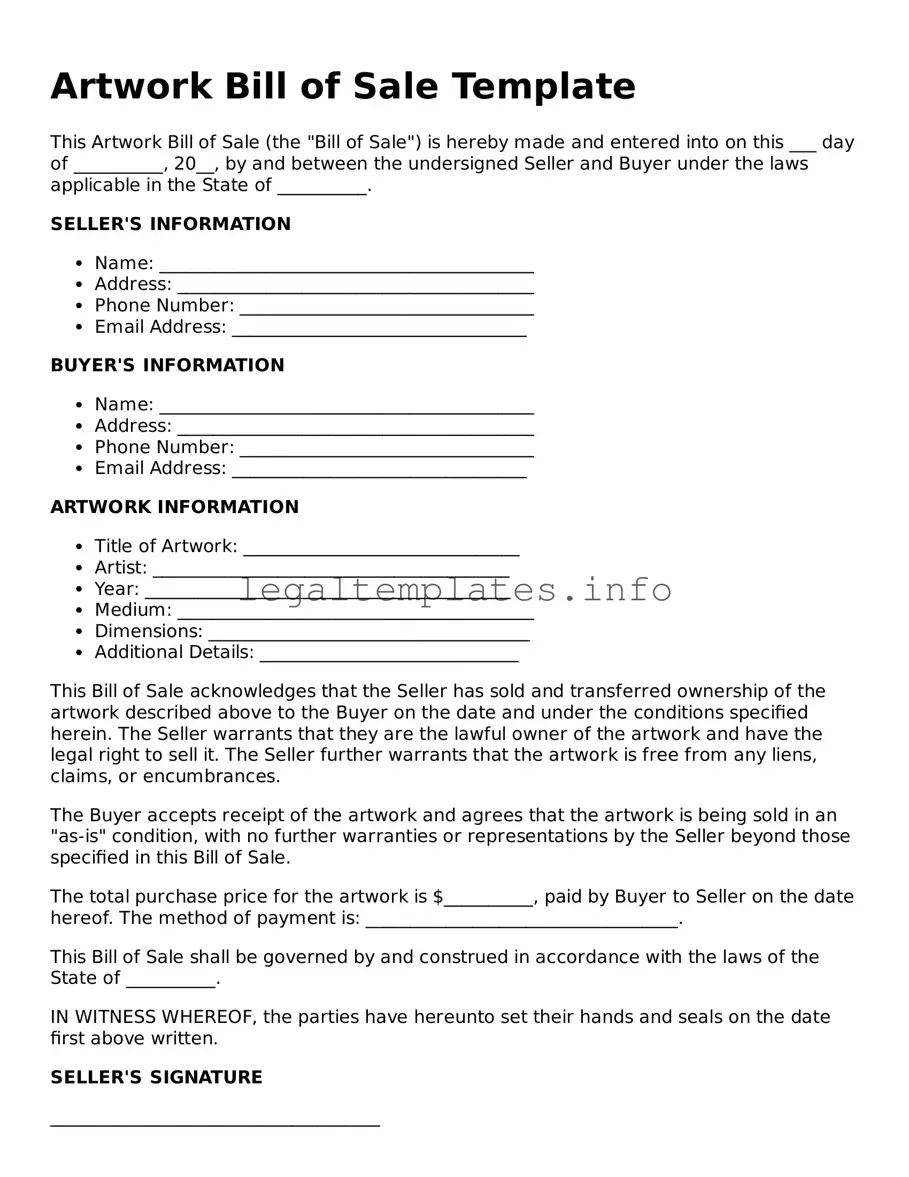The Artwork Bill of Sale form is analogous to a Vehicle Bill of Sale form in that both serve as official records of a transaction, transferring ownership from one party to another. They both document critical details such as the identification of the item being sold (artwork or vehicle), the sale price, and the names and signatures of both the seller and buyer. These forms act as legal evidence of the change in ownership and are often required for the registration of the item (vehicle registration or artwork provenance documentation).
Similarly, a General Bill of Sale form shares commonalities with the Artwork Bill of Sale, as it is utilized for transactions involving personal property. However, the General Bill of Sale is more versatile, covering a wide range of items beyond artwork, such as electronics, appliances, and furniture. Like the Artwork Bill of Sale, it includes details about the buyer, seller, item, and sale conditions, providing a record that legally supports the transfer of ownership.
A Real Estate Bill of Sale form, while used for transactions involving property, resembles the Artwork Bill of Sale in its function of documenting the sale and transfer of ownership. Both forms capture specific details about the sale, including the parties involved and the sale price, but the Real Estate Bill of Sale specifically pertains to physical land or buildings, highlighting the breadth of bill of sale documents across different asset categories.
The Promissory Note is akin to the Artwork Bill of Sale in that it documents the terms of a transaction. A Promissory Note outlines the details of a loan's repayment, including the principal amount, interest rate, and payment schedule, whereas the Artwork Bill of Sale confirms the sale and transfer of an artwork piece. Both are crucial for providing a legal framework for the agreement and ensuring the parties' obligations are clear.
An Equipment Bill of Sale shares similarities with an Artwork Bill of Sale, as they both provide a legal record of the sale and purchase of a specific item. This document is particularly used for the sale of machinery or larger equipment, detailing the condition, specific identification, and any warranties, similar to how an Artwork Bill of Sale would describe the piece, its condition, and any authenticity guarantees.
A Business Bill of Sale is related to the Artwork Bill of Sale in its purpose to document the sale of assets. However, it specifically pertains to the sale of an entire business or a substantial part of its assets, which can include everything from physical products to intellectual property. This form ensures the rights, ownership, and obligations are transferred from the seller to the buyer, echoing the functionality of an Artwork Bill of Sale on a broader business scale.
A Receipt of Sale is a simple document that, like an Artwork Bill of Sale, provides proof of a transaction between two parties. Although it is less detailed and typically doesn’t include specific terms of the sale beyond the basic information (item description, price, and parties involved), it functions as an acknowledgment of the payment received and the transfer of ownership for items sold, including artwork.
A Warranty Deed, used in real estate transactions, parallels the Artwork Bill of Sale by guaranteeing that the seller holds clear title to the property (art or real estate) and has the right to sell it. While serving different markets, both documents protect the buyer by ensuring the item or property is free from liens or claims, providing a clear transfer of ownership backed by legal assurances.
Lastly, a Lease Agreement, though primarily used for rental arrangements rather than sales, shares with the Artwork Bill of Sale the characteristic of documenting an agreement between two parties. It outlines the terms under which one party agrees to rent property owned by another party. This comparison highlights the fundamental purpose of these documents to define the terms of an agreement, ensuring all parties have a clear understanding of their rights and responsibilities.
